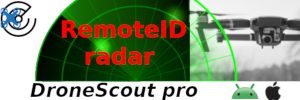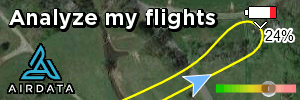D
Deleted member 114292
Guest
First the only really new thing for me is that they ditched the idea of internet based RID, which is not a great idea in practice.
It would have required a subscription and would have been very hackable plus presented numerous implementation headaches.
I typically do not have internet on my paid missions, which is in general fine but would make RID tricky.
No doubt they learned that in the LAANAC roll out - not as easy as it sounded.
But this:
"Broadcasts remote ID messages directly from the UA via radio frequency broadcast (likely Wi-Fi or Bluetooth technology), and broadcast will be compatible with existing personal wireless devices."
Tells me they are far from an actual working specification for the actual implementation details.
First Bluetooth - really? The FCC specification limits Bluetooth to 30 Meters so I can't see how that is going to work. Wether you have noticed or not Bluetooth is already overloaded with devices. Are you going to Pair with drone (no)? You can have a no pairing BLE device but still too range limited.
It sounds like they would like it so your phone could receive the RID data out of the box, but that is not as easy as it sounds. For one thing, compared to your RC your phone is a really bad RX device.
The antenna on your phone has at least a factor of 10 less gain than your RC. The front end of the WiFi chip on your phone is also not up to the job, compared to your RC.
My phone loses WiFi by the end of my driveway, then add in the high level of interference in many areas.
The reason why you can make a call is because cell phone towers can transmit at upto 80 watts, and have super optimized antennas, not to mention high end low noise receivers.
Then there is the matter of your phone being on the same network at the drone, or a router that can route between the two hosts. The only way I can see this working is if the drone is an AP (access point like your wifi router is). This is how Tello and other drones work so you would have to go to your wireless settings and connect to the drone you wish to monitor. Of course then you can only monitor one drone at a time and will have to sort thru perhaps a long list of APs to find it. I suppose you could dictate that drones have SSIDs that follow a certain format so you could have an app that finds them. But then the AP would not have a password so your drone could end up being hackable.
All I am saying is that the requirement to be "compatible with existing personal wireless devices." may box them in to a less than optimal specification. Not saying there is no solution, just not that easy to work out. Probably someone smarter than me has a better idea, but those are my thoughts.
No ADS-B out because that would totally jam up those frequencies.
All in all this is no simple task, and if the FAA was smart they would go to "Uncle Charlie" (what Hams would call the FCC) and get them to sort it out. The FCC is already not going to be happy with perhaps millions of drones high in the sky clobbering WiFI. It's bad enough in your neighborhood, but from the drones altitude it can clobber 20 neighborhoods at once.
My real point is this is far from ready for prime time. No doubt there will be an industry standards committee, which means at least another year of debate (ok arguments). I was on the FIDO standards committee and it took years and at least 3 major revisions before it was done, and that was just for a simple FOB that lets you log in. A battle of the Egos.
And then once you get a standard, it will take manufactures some amount to implement it. And then fix the bugs.
It would have required a subscription and would have been very hackable plus presented numerous implementation headaches.
I typically do not have internet on my paid missions, which is in general fine but would make RID tricky.
No doubt they learned that in the LAANAC roll out - not as easy as it sounded.
But this:
"Broadcasts remote ID messages directly from the UA via radio frequency broadcast (likely Wi-Fi or Bluetooth technology), and broadcast will be compatible with existing personal wireless devices."
Tells me they are far from an actual working specification for the actual implementation details.
First Bluetooth - really? The FCC specification limits Bluetooth to 30 Meters so I can't see how that is going to work. Wether you have noticed or not Bluetooth is already overloaded with devices. Are you going to Pair with drone (no)? You can have a no pairing BLE device but still too range limited.
It sounds like they would like it so your phone could receive the RID data out of the box, but that is not as easy as it sounds. For one thing, compared to your RC your phone is a really bad RX device.
The antenna on your phone has at least a factor of 10 less gain than your RC. The front end of the WiFi chip on your phone is also not up to the job, compared to your RC.
My phone loses WiFi by the end of my driveway, then add in the high level of interference in many areas.
The reason why you can make a call is because cell phone towers can transmit at upto 80 watts, and have super optimized antennas, not to mention high end low noise receivers.
Then there is the matter of your phone being on the same network at the drone, or a router that can route between the two hosts. The only way I can see this working is if the drone is an AP (access point like your wifi router is). This is how Tello and other drones work so you would have to go to your wireless settings and connect to the drone you wish to monitor. Of course then you can only monitor one drone at a time and will have to sort thru perhaps a long list of APs to find it. I suppose you could dictate that drones have SSIDs that follow a certain format so you could have an app that finds them. But then the AP would not have a password so your drone could end up being hackable.
All I am saying is that the requirement to be "compatible with existing personal wireless devices." may box them in to a less than optimal specification. Not saying there is no solution, just not that easy to work out. Probably someone smarter than me has a better idea, but those are my thoughts.
No ADS-B out because that would totally jam up those frequencies.
All in all this is no simple task, and if the FAA was smart they would go to "Uncle Charlie" (what Hams would call the FCC) and get them to sort it out. The FCC is already not going to be happy with perhaps millions of drones high in the sky clobbering WiFI. It's bad enough in your neighborhood, but from the drones altitude it can clobber 20 neighborhoods at once.
My real point is this is far from ready for prime time. No doubt there will be an industry standards committee, which means at least another year of debate (ok arguments). I was on the FIDO standards committee and it took years and at least 3 major revisions before it was done, and that was just for a simple FOB that lets you log in. A battle of the Egos.
And then once you get a standard, it will take manufactures some amount to implement it. And then fix the bugs.











